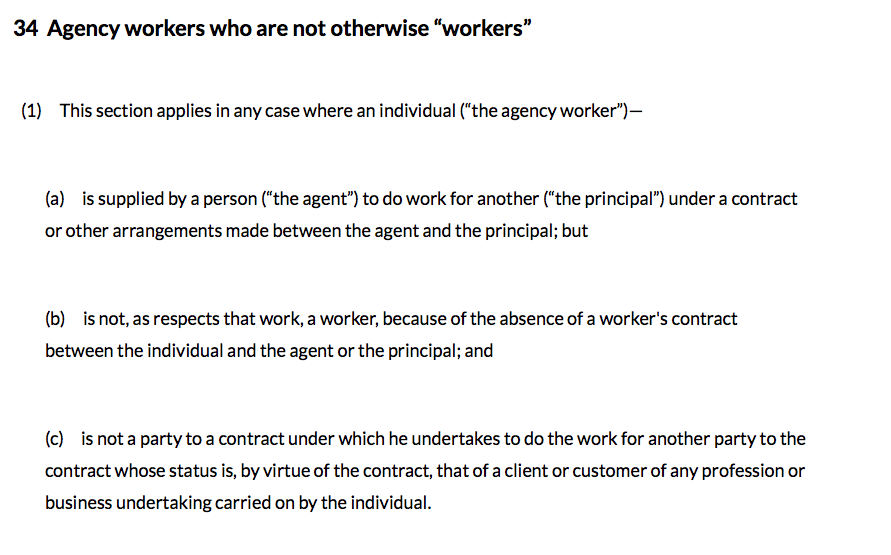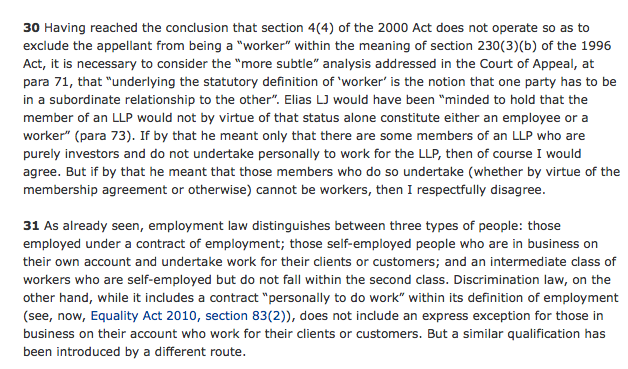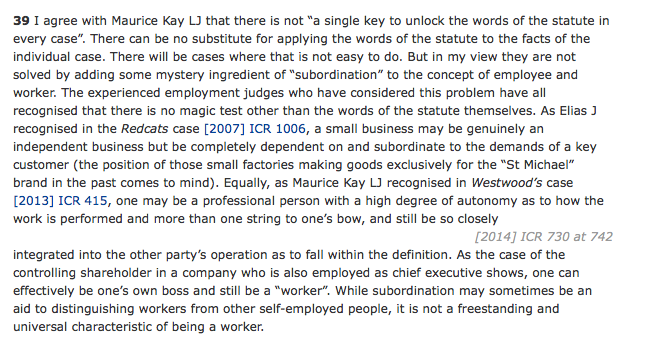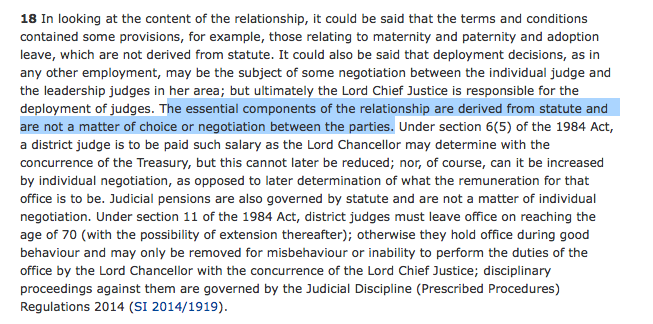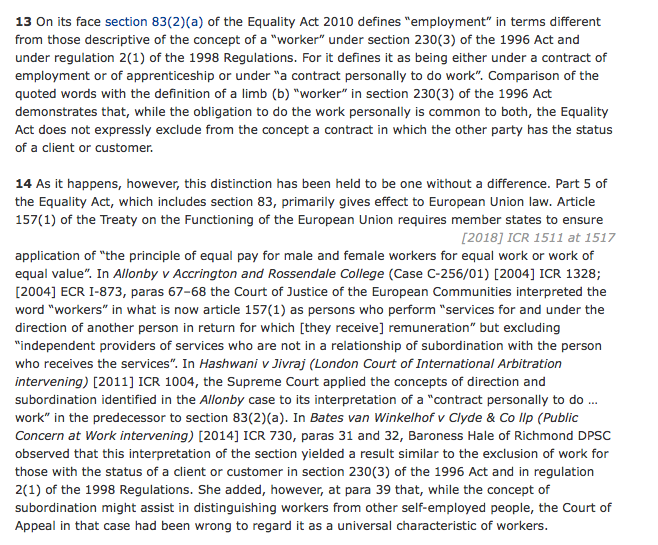1/ #Uber Supreme Court occasional thread: 3 features to limb (b): 1) Contract to do work for another; 2) personally; 3) not in customer relationship. These are the features required by Parliament for entitlement to minimum wage. #ukemplaw
2/ Lord Leggatt is concerned about the provisions against contracting out. @DinahRoseQC makes clear those provisions (s.49 NMWA) don& #39;t impact on the interpretation of whether an arrangement falls within limb (b), but only where the contract does fall within that relationship.
3/ The starting point must be the contract, with parties free to enter into an agreement outside of limb (b). There& #39;s no warrant for adopting a broad construction of limb (b) or a special approach to interpretation of contract (the batter between CA majority & minority).
4/ 1st authority referred to is Bankway - doing the groundwork on the key battleground for how the Court should construe its judgment in Autoclenz (as Bankway was key to Lord Clarke& #39;s judgment). Emphasis on repugnance of the contractual drafting in that case.
5/ This is really the nub of Underhill LJ& #39;s dissent - freedom to contract however the parties choose; only go to Autoclenz if the terms of contract are repugnant to the reality of the relationship.
6/ @DinahRoseQC turns next to s.34 NMWA - noting that that extended the worker definition to catch a vulnerable group of workers.
7/ Suggests that this shows a legislative choice to extend the scope of limb (b) to cover a particular situation. Parliament could have chosen to extend limb (b) to the Uber situation, but hasn& #39;t done so to date.
8/ This is followed up with showing how Parliament made similar definitional extensions under the ERA in s.43K. Laying the groundwork for a narrowly textual construction of s.230(3)(b) and leaving broadening to Parliament.
9/ Whether or not she succeeds, @DinahRoseQC is giving an advocacy object lesson in structuring submissions. Take the tribunal (or appeal court) down a path and try to lock each door behind you, so that to find against you they have to go to the effort of unlocking each door.
10/ Moving on to look at Bates van Winkelhof v Clyde & Co. Focusing on the connections between s.230(3)(b) ERA and s.80(2) EqA - which will allow her to bring in the helpful (to Uber) judgments on s.80 in Mingeley v Pennock.
11/ Heavy reliance is placed on Lady Hale& #39;s well-known disregard for subordination as part of the limb (b) worker test.
12/ Moving on to Gilham v MoJ (a s.43K case where the Supreme Court found judges fell within the extended definition of worker). Relying on this case as an orthodox approach to the statutory wording to determine whether the relationship fell within that wording.
13/ @DinahRoseQC relies on the SC acknowledgement in Gilham of the statutory requirements governing the judicial relationship as showing the CA was wrong in Uber to count against Uber that parts of their relationships with drivers resulted from statutory requirements, not choice.
14/ Elements a party applies due to statutory obligation should not be weighed in the balance against Uber in determining the relationship. The Court of Appeal erred in holding otherwise. It would be different if the statutory scheme required employment of drivers as workers.
15/ Moving on next to Pimlico Plumbers v Smith, @DinahRoseQC notes that that case concentrates on the 2nd and 3rd elements of limb (b) and not the first. Notes again the Supreme Court repeated that the ERA s.230(3)(b) & EqA s.80(2) apply the same test.
16/ Moving on to Autoclenz now. @DinahRoseQC submits it can& #39;t be the law that different principles of contractual construction apply when a party submits that a contract falls within the relationships under the ERA.
17/ Notes that in Autoclenz the dominant party had a commercial incentive to record in writing an agreement which in terms don& #39;t accord with the substance of the actual relationship.
18/ This may be relevant to identifying the true terms of an agreement and whether the written terms accurately record the substance of the agreement. This isn& #39;t restricted to the employment context.
19/ @DinahRoseQC submits the written terms should be the starting point of analysis rather than relegated to just one factor or to a situation where the court is invited to deduce the contractual terms disregarding the written terms.
20/ Where conduct is ambiguous vis-a-vis the terms, that shouldn& #39;t open the door to a wide Autoclenz construction of the terms. If the acts are consistent with the written terms, the court shouldn& #39;t apply an abnormal approach to contractual construction.
21/ Lady Arden wonders whether one should still be required to ponder whether the written terms are the complete terms (the Carmichael situation). @DinahRoseQC accepts that but that it is not this case.
22/ [Short brownie break intermission] (a benefit of working from home, see: https://twitter.com/JasonBraier/status/1285506638716248064">https://twitter.com/JasonBrai... - I can report it is very good indeed)
23/ Key considerations are 1) consistency between written terms with the actual relationship, and 2) how those terms are categorised under the various statutory categories of relationship.
24/ Lord Reed gives a glimpse into his thought processes - that the legislation has a protective purpose & that that should be key to the analysis (clearly having read @thebigbogg & @MichaelFordQC& #39;s case comment on the CA judgment).
25/ @DinahRoseQC seeks to turn that around by suggesting the statutory purpose is to protect those falling within the statutory definitions - i.e. don& #39;t extend the protective purpose so that it& #39;s a big statutory hug trying to bring everyone into its arms.
26/ @DinahRoseQC emphasises the exercise IS one of contractual construction. Parliament has chosen to establish the limits of the rights through a contractual framework. Wrong for courts to break free of the chains of a party& #39;s contract by relying on a broader purposive approach.
27/ Lord Leggatt considers Autoclenz doesn& #39;t start from a presumption that the written agreement is what has been agreed (the L& #39;Estrange approach) but looking at what has actually been agreed.
28/ He makes the alarming suggestion that if the driver hasn& #39;t read the agreement, the written terms may not even & #39;get through the door& #39;. @DinahRoseQC suggests that would throw the normal contractual construction terms out of the window. Perhaps time to bring in Secret Hotels2?
29/ The mid-morning virtual break brings down the curtain on Act One. For Act Two, have Autoclenz to hand! https://www.bailii.org/cgi-bin/format.cgi?doc=/uk/cases/UKSC/2011/41.html&query=(autoclenz)">https://www.bailii.org/cgi-bin/f...
30/ Expect @dinahrose to start Act 2 by coming back against Lord Leggatt& #39;s suggestion that you throw ordinary principles out of the window with the qualifying terms set out in Autoclenz para 22. Hence Uber& #39;s case of consistency between written terms & actuality.
31/ During the break I& #39;m listening into my wife& #39;s away day. They are still talking brownies! They& #39;ve now moved on to focaccia. I think we need zoom away days at @42BR_Employment

 Read on Twitter
Read on Twitter